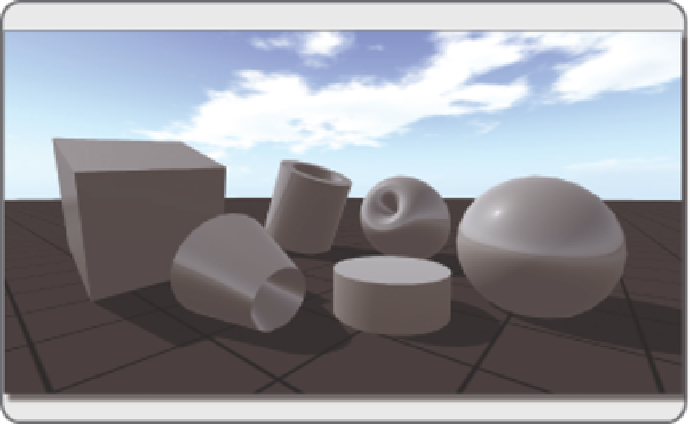Game Development Reference
In-Depth Information
FIGURE 6.1
Screen grab from OpenSim showing the basic 3D solids called prims that are available in the Build
Menu. They are shown with lighting to display their unique forms. Pictured here from the left side are: a cube, ring,
tube, cylinder, torus, and sphere.
to great effect on Cinderella's castle in Disney World. The upper battlements are reduced in scale proportion-
ally, making the structure look twice as tall as it actually is [1].
Changes in contrast, detail, and focus will also cause our brains to assume changes in 3D spatial relation-
ships. An object that has more contrast with a greater range of light and shadow on its surface will look closer
to the observer, whereas an object that is grayed out and muted in shadow and highlights will look more dis-
tant. You can see examples of this on a foggy night in a city environment as the haze in the air makes build-
ings down the block look more distant. This atmospheric perspective can be utilized in virtual worlds by
changing the WindLight Settings (Second Life) or Light Share (OpenSim) for your environment (see Chapter
8 for more details on lighting). Diminishing the amount of surface detail in distant objects and softening their
edges with semitransparent textures will also increase the feeling of distance. Conversely, if you add more
detail to your 3D model and enhance the edges of your object's textures, it will seem nearer to the observer.
In Figure 6.2, examples of these kinds of perspective are displayed: contrast, detail, and atmospheric. As you
can see, they are very effective ways to alter how 3D form is perceived. They are used all around you in the
real world—in theme parks, on the stage, or in store displays—so why not put them to use in a virtual one?
6.2 PICKING A 3D MODELING PROGRAM AND A METHODOLOGY FOR BUILDING
You have numerous choices as there are many 3D modeling packages. 3DS Max, Maya, Blender, Modo,
Cinema 4D, Cheetah3D, SketchUp—the list goes on and on, lengthening with each year as new 3D model-
ing programs and interfaces are developed. As a designer, you are used to making choices, so look for the
3D modeler that will work best for you in these three ways: (1) operating system, (2) price, and (3) capacity
(or software features). Grade them on a scale of 1 to 10 and try the demo versions of the top three on the list.
Granted, learning your irst 3D program and developing your 3D mind-set may seem a bit overwhelming
at irst, but as you progress, you will ind that many of these programs utilize similar tool sets. You may have
a limited budget for software, but that should not stop you. In almost all categories, there is a free or low-cost

